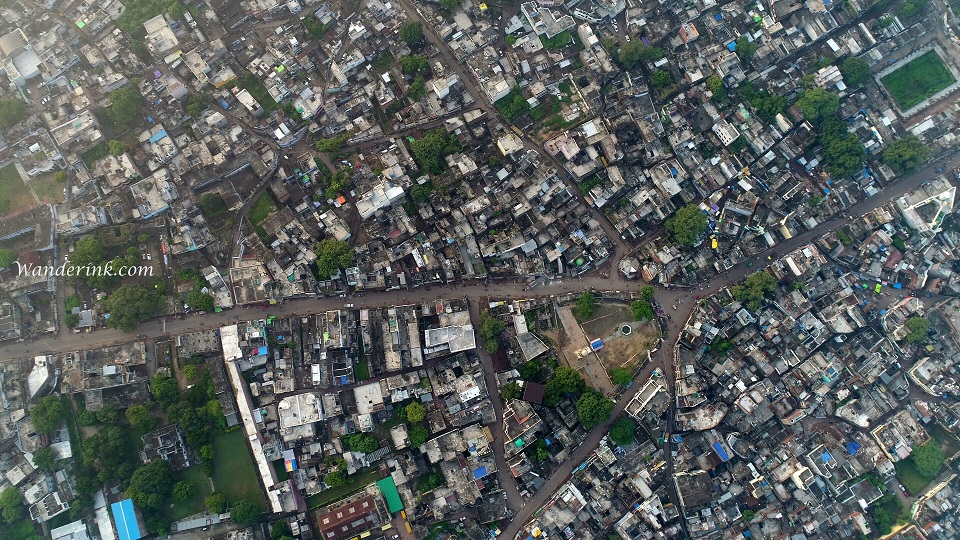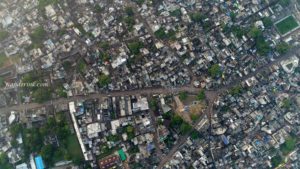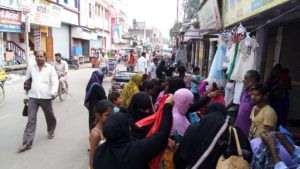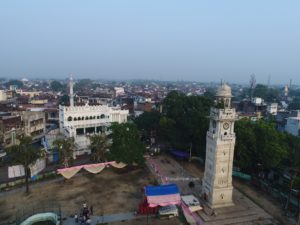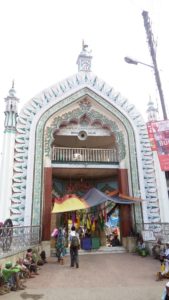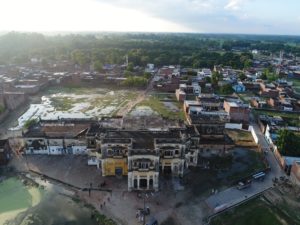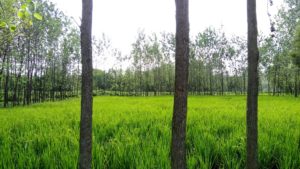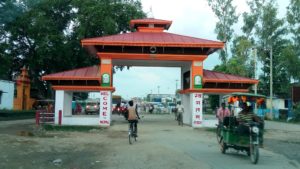There is not much difference when you look at Bahraich from half a kilometre in the sky and from street level. It is a tumbleweed cluster of shanty dwellings, lean-to shops, road-facing sculleries, pointy minarets, lowing buffaloes snacking on plastic, milling rickshaw pullers and little figurines cowering in black, chaffering with lingerie and veggie vendors on pushcarts. Main drags radiate like a Merc-sign from the town centre, the ‘Ghantaghar’ or Clock Tower. The grounds of this Raj relic are the only place where you can stretch your limbs without assaulting somebody. Even this is taken over by religious speech-givers and their rapt followers by evening. Not very far away at a busy intersection on a makeshift stage, adherents of another religion are welcoming the festive season around the corner with much chorusing and chanting.
“This is a sensitive area,” informed a friend, a local guy, who was taking us around. “Though there have been no major communal flare-ups, skirmishes aren’t that rare either.” Later that evening, walking to our hotel after dinner, we saw two guys approach blows – one of them wore a religious skullcap. There was a traffic jam till some wizened passers-by intervened and dispersed the slagging hotheads. Someone said they promised each other to meet again, soon.
We were in Bahraich, 120 km from Lucknow, to film the success of a marketing company operating in the hinterlands and the empowerment it was bringing about. Bahraich could very well do with all the help. It is one of the most backward districts not just in Uttar Pradesh but in the country itself. And this is despite its strategic location less than 60 km away from Nepal border. On most parameters of development, according to the Ministry of Minority Affairs, Bahraich is well below national average; the sex ratio is skewed and literacy barely 50 per cent. Probably the tumultuous times, I must say the roads were largely well-maintained though, commutable at high speeds. The idea is to facilitate army movement in case of neighbourly troubles.
Laying a finger on the tenuous pulse is the Syed Salar Dargah a few minutes from the town centre. This is where Syed Salar Masud, cousin of the great invader Mahmud of Ghazni, is buried. Syed Salar was killed by the legendary Hindu king Suhaldev in battle. That the Syed was just and valorous, or not; was tricked into capture, or lost a fair fight; depends on whom you ask. The place is teeming with benevolence-seekers and looks like a refugee camp. Laundry and cheap plastic wares line the path till the inner sanctum where Syed Salar rests. Against dargah norms, some snotty-nosed kids in tattered rags approach us for alms and are shooed away by our cabbie, Nasser, himself a devotee.
“I come here every year with my family to pay obeisance to the sheikh,” Nasser informed me. He was happy that this year he would be making it twice. I told him that Syed Salar should be given more time to think about his subjects in his immediate vicinity and later about those farther away. He cut me short with a request for one thousand rupees to put in the donation box. I gave him five hundred which he took without grumble. Minders to every saintly tomb coaxed money from visitors and some even belligerently so. I ran out of small denominations before our local friend stepped in and began waving away the pir-guards and elbowing our way through a melee of them.
The day we arrived in Bahraich was a washout, the roads were inundated with rain and sewage water. Cows sat on the road with a ‘what-will-you-do-now’ look and rodents scurried between drainages during lulls.
“The returning monsoons has started today and should go on for at least a week,” the hotel manager informed us cheerily at check in.
Though the humidity was a killer, we got sunny days soon after. We were able to wrap up our shoot as per schedule. I pointed this as a lucky ‘Salar-stroke’ as we headed back to Delhi. In the rear mirror I espied a beaming Nasser.
Nanpara, 35 km from Bahraich, is an important frontier town with a lot of history. With 439 villages, its Raja was the largest holder of Muslim villages in British India. We were passing by on our way to Sankalpa village, 5 km away. With Nepal itself just another 15 km from here, there is a commingling of populations; dark, wiry farmers from this side of the border with fair, plump Nepali wives are a regular sight. The husbands smiled at me with pride when I stared at their prized possessions. Their kids were catlike, lithe, and had light eyes. We stopped by the Raja Kothi in Nanpara, once inhabited by the rulers, now dilapidated and embroiled in a legal tussle between current heirs. My local friend was one of them. My suggestion of all heirs getting together -> sorting out differences -> chipping in monies -> restoring some -> starting a heritage stay was easier said.
“The expenses are prohibitively high and nobody wants to take that chance,” he said, echoing the exact sentiments of the heirs of a thousand dilapidated havelis in the Shekhawati alone.
The Ghaghara River which originates near the Lake Manasarovar in Tibet becomes the Sarayu as it flows into the Indian plains. This is the second largest tributary of the Ganges after the Yamuna but carries more water. The holy kingdom of Ayodhya was supposed to have been situated on its banks. Today it courses through large tracts of Uttar Pradesh including Bahraich and parts of Bihar. In Bahraich it flowed like shallow silt, bearing the brunt of untreated effluents. The farther we went from the town, the river began to gather vigour and colour. The surrounds became more verdant. Sankalpa itself shone like it caught the rays off the Kohinoor. Then, as with most places flaunting such natural affluence, the inhabitants themselves were an impoverished lot and worse still, oblivious to the magnificence that was all around them. Forget toilets for all, here, I am giving it to you in writing, that even decent houses by 2022 is a fantastic electoral plank.
Scenes at Rupaidiha, border town, were subdued chaos. It was mostly Nepalis who were engaged in border commerce, plying across the checkpoints in overladen electric rickshaws. Indian security guards were arborescent in their rootedness while their Nepali counterparts lumbered along with darting eyes. What strikes you is how thoroughly they body-check those walking across the border carrying their tools of trade – a few spanners, most of the time – while the spilling-over rickshaws are at best given a once-over. We reached the border by 5:30 PM and had to pay INR 300 for vehicle pass; entry till 4:30 PM is free. We drove on till the BP Koirala junction in Nepalganj.
Since, (1) we couldn’t spot any tea stall, (2) alcohol was way more expensive than in India, and, (3) we were carrying our own supply, we decided to turn back. Back at the border we were required to exposit our imminent return to an Indian border guard who steadied himself on our window. The real reason we went across the border proved to be too uneventful to be credible: one of the shoot assistants had never stepped on foreign soil. From inside the car, we could hear imprecations beneath an intoxicated breath. A canon-like lamp tucked into his armpits bathed us in a sick bluish-white light. Our quick return seemed like an act of perfidy. We locked eyes.
One crew member, slightly drunk himself, leaned towards the window and beckoned the guard close.
“Sir,” he slurred, “we went across the border because we wanted to undertake an antarashtriya (international) mutradaan (micturition).”
It is incredible how things work in India sometimes.
(All photographs and videos are copyrighted by Wanderink.com; all you need to reproduce any is just ask.)


